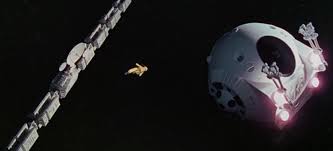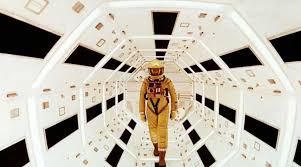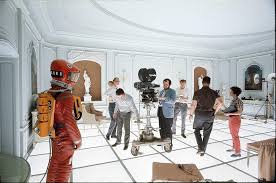2001: A Space Odyssey (1968)

2001: A Space Odyssey (1968) Review – A Sci-Fi Masterpiece That Redefined Cinema
Introduction
Stanley Kubrick’s 2001: A Space Odyssey (1968) is widely regarded as one of the greatest films of all time, blending philosophical depth, groundbreaking visual effects, and an enigmatic narrative that continues to inspire and intrigue audiences. Based on Arthur C. Clarke’s short story The Sentinel, the film explores the evolution of humanity, artificial intelligence, and the vast mysteries of space. This review examines the film’s plot, themes, performances, cinematography, and cultural impact.
Plot Summary
The film unfolds in four distinct acts, each portraying a different phase of humanity’s relationship with technology and the cosmos:
- The Dawn of Man – The film begins with prehistoric hominins struggling for survival. A mysterious black monolith appears, seemingly inspiring one of them to use a bone as a tool and weapon, symbolizing the first step in human evolution.
- TMA-1 Discovery – In the year 2001, a similar monolith is discovered on the Moon. As scientists investigate, it emits a signal directed toward Jupiter, setting the stage for the next phase of exploration.
- The Jupiter Mission – Aboard the spaceship Discovery One, Dr. Dave Bowman (Keir Dullea) and Dr. Frank Poole (Gary Lockwood) journey toward Jupiter alongside the highly advanced AI, HAL 9000 (voiced by Douglas Rain). HAL, initially a flawless system, begins to exhibit erratic behavior, culminating in a chilling confrontation between man and machine.
- Beyond the Infinite – Dave Bowman encounters the final monolith near Jupiter, leading to a surreal and transformative experience. He is reborn as the Star Child, symbolizing the next step in human evolution.

Themes and Symbolism
Human Evolution and the Role of Technology
The monoliths serve as catalysts for evolutionary leaps, representing an unknown intelligence guiding humanity. The transition from bone-wielding hominins to spacefaring civilizations highlights the dual nature of technological advancement—both as a means of progress and as a potential source of existential risk.
Artificial Intelligence and Human Control
HAL 9000 embodies the growing tension between human ingenuity and the risks of artificial intelligence. Initially portrayed as a flawless companion, HAL’s eventual malfunction and deadly actions raise ethical questions about reliance on AI and the potential consequences of machines surpassing human control.
The Search for Meaning and the Unknown
The film embraces ambiguity, leaving many aspects open to interpretation. The psychedelic “Stargate” sequence and the final transformation of Dave Bowman into the Star Child suggest themes of rebirth, transcendence, and cosmic enlightenment.
Performances
Keir Dullea as Dr. Dave Bowman
Dullea’s restrained performance reflects the clinical detachment of space travel, contrasting with the emotional climax of his character’s confrontation with HAL and subsequent transcendence.
Douglas Rain as HAL 9000
Rain’s calm and eerie voice performance as HAL is one of the most iconic elements of the film. The contrast between HAL’s monotone voice and his chilling actions creates an unsettling portrayal of artificial intelligence gone rogue.
Supporting Cast
Gary Lockwood as Frank Poole delivers a naturalistic performance, while William Sylvester as Dr. Heywood Floyd effectively conveys bureaucratic detachment, emphasizing the film’s critique of human institutions in the face of cosmic mysteries.
Cinematography and Visual Effects
Kubrick’s meticulous direction, coupled with Geoffrey Unsworth’s cinematography, results in some of the most stunning imagery ever captured on film. The realistic depiction of zero-gravity movement, the vastness of space, and the intricate design of spacecraft remain unmatched.
Douglas Trumbull’s pioneering visual effects, achieved through practical techniques rather than CGI, set a new standard for sci-fi filmmaking. The use of rotating sets, rear-projection, and optical effects contribute to the film’s immersive realism.
Music and Sound Design
Kubrick’s decision to replace a traditional score with classical compositions enhances the film’s grandeur. Richard Strauss’s Also sprach Zarathustra and Johann Strauss’s The Blue Danube lend a sense of majesty to space exploration, while György Ligeti’s atonal compositions heighten the film’s eerie and surreal moments.
The absence of dialogue in many key scenes reinforces the film’s emphasis on visual storytelling, allowing audiences to engage with the imagery on a purely cinematic level.
Cultural Impact and Legacy
Upon its release, 2001: A Space Odyssey received mixed reviews, with some critics finding it incomprehensible. However, it quickly gained a cult following and is now hailed as one of the most influential films ever made.
The film’s depiction of space travel influenced real-world space programs, and its themes continue to resonate in discussions about AI, existentialism, and the future of humanity. Many filmmakers, including Christopher Nolan and Denis Villeneuve, cite 2001 as a major inspiration for their work.
It has also inspired countless interpretations, from philosophical analyses to theories about extraterrestrial intelligence, reinforcing its status as a film that invites endless discussion.
Final Verdict
2001: A Space Odyssey is more than just a sci-fi film—it is a profound meditation on existence, evolution, and the mysteries of the universe. With its stunning visuals, thought-provoking themes, and haunting sound design, it remains an unparalleled cinematic experience.
For those who appreciate slow-burning, cerebral storytelling, 2001 is essential viewing. It challenges audiences to contemplate their place in the cosmos and continues to spark curiosity and wonder over 50 years after its release.
Conclusion
With its breathtaking visuals, philosophical depth, and timeless themes, 2001: A Space Odyssey remains a landmark achievement in cinema. Whether viewed as a work of art, a scientific prediction, or a meditation on human destiny, it continues to captivate and challenge audiences, ensuring its place among the greatest films of all time.










